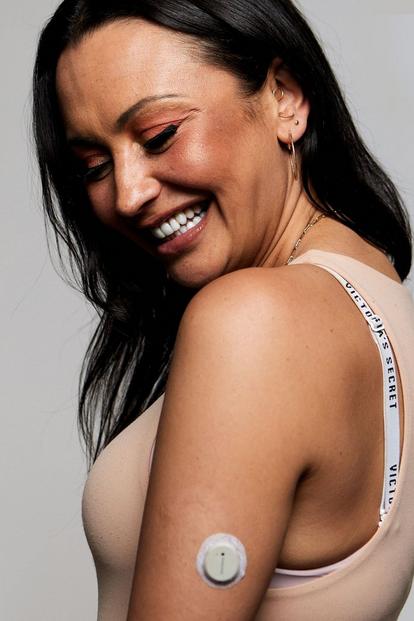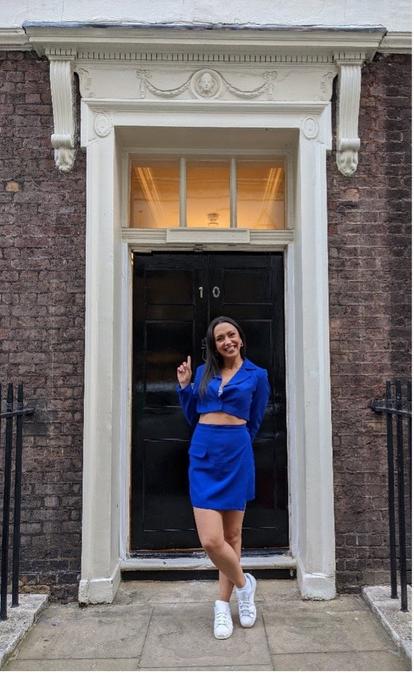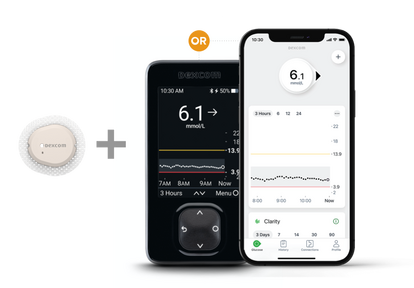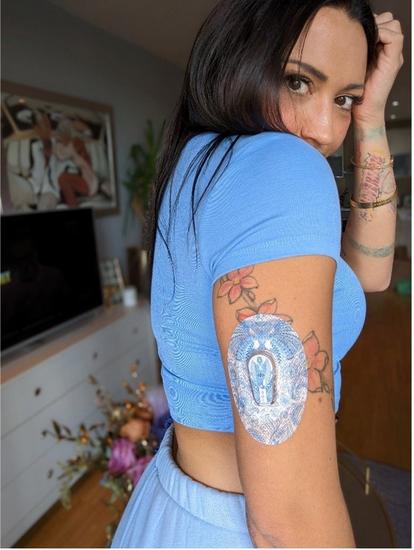
Blog - Warrior Stories
Dexcom G7 Review with Warrior, Natalie
Reality TV star, broadcaster and Dexcom Warrior, Natalie*, shares her inspiring diabetes story. Having used the Dexcom G7 Continuous Glucose Monitoring (CGM) System since February 2022, she tells us about some of her favourite features, alerts, and how it compares to the Dexcom G6.
Meet Dexcom G7 Warrior, Natalie
36-year-old Dexcom Warrior Natalie is based in Manchester, living with her little dog, Tito. Being diagnosed with Type 1 diabetes (T1D) at the age of 20 was initially debilitating due to the lack of support and knowledge about her condition at the time. But through education and joining empowered diabetes communities, including Dexcom Warriors, it has inspired her to become an advocate within her passions for performing arts, theatre, fashion, and now politics.
Back in 2017, Natalie was working for the NHS as a communications director, as well as on her passion project, Type 1 Clothing. It took off quickly and, along with her vibrant personality and online presence, led to her being approached to do reality TV. In 2022, she starred in Make Me Prime Minister, going on to win series 1 and being crowned Britain’s alternative prime minister.
She’s now moved into broadcasting and politics, being an advocate for diabetes, healthcare and mental health. Instead of her condition holding her back, it’s helped to take her all over the world. And the ease of the Dexcom CGM Systems has allowed her to manage her condition while on the road.
With her inspiring words of “anything you can do, I can do with diabetes”, learn more about Natalie’s story and experience with the Dexcom G7.
1. Tell us about how you were diagnosed with type 1 diabetes and how it made you feel.
After feeling some of the symptoms, I was diagnosed at the age of 20. It’s a strange time because I felt like both a child and an adult. I was expected to act like an adult and take responsibility for my health at a very young age, but with very little information on how to manage the condition.
With the change in my lifestyle, it affected my relationships, and I lost a lot of friends. Coping with the diagnosis was very hard at first. I felt broken and struggled with mental health problems, like depression and anxiety. There was also a lack of understanding and support back then. I feel like if I was diagnosed today, it would be a lot easier as there are so many support groups now.
I often say that diabetes is both the worst and the best thing that’s ever happened to me as it’s given me so much. While it was a horrible experience at first, it’s given me a community, a sense of understanding, strength, and an appreciation for everything in my life.

2. What changes did you make to your daily life after being diagnosed?
Having just started my adult life, I went from being a typical 20-year-old party animal to staying at home a lot. At first, I found this hard but the diagnosis forced me to start looking after myself. I gave up drinking and smoking and started focusing on my health – both my physical and mental wellbeing.
Because of the lack of information back then, I initially had no idea how to manage my diabetes and diet, thinking that typically ‘bad food’ would mean I’d have to take more insulin. Learning more about diabetes later, I joined a community and became better informed about living with the condition, as well as concepts such as CGM, insulin and carb counting*.
3. Did your diagnosis affect any of your hobbies, passions or relationships?
At the age of 20, I was planning on being a dancer. The effects of T1D, followed by severe hypos and seizures, as well as the mental strain meant that I could not pursue my passion at the time. The diagnosis changed my whole life, it changed who I thought I was, it changed what I thought I was going to do, it changed my friend group. When I stopped partying, a lot of people who I thought were my friends stopped calling. It was hard at first but in the long run, it showed me who my true friends were.
Having joined communities and with the knowledge I have now, I can use diabetes as a motivator for my passions and hobbies. In fact, having hosted TAD in March 2022, the line that got the biggest applause was where I said: “anything you can do, I can do with diabetes”.
4. Before you started using Dexcom CGM products, how did you manage your diabetes (other CGMs, treatments, lifestyle, etc)?
I tried a competitor brand for a few months before using Dexcom. I was struggling with it – it kept flat lining and giving me inaccurate readings. At that point, I was feeling very disheartened with the idea of any kind of glucose monitor. The system was just giving me a lot of anxiety. Already having generalised anxiety disorder, I didn’t want to use anything or do anything that would add to my stress.
Prior to Dexcom, I also started carb counting to determine how much insulin I would need before or after meals which can be quite time consuming and overwhelming at times.
5. How did you hear about Dexcom and why did you choose a Dexcom CGM system?
Back in 2017, I was doing Type 1 Clothing and was all over the BBC. Dexcom reached out to me and sent through a sample kit of the Dexcom G5. It was intimidating at first but weirdly enough, even the older generation system didn’t hurt when inserting it. I tested my blood sugar levels even more than I normally would, determined to prove that CGMs didn’t work. I was surprised by how accurate it was and Dexcom offered to work with me.
The difference between my glucose control before, while using the other system, compared to 3 months of using Dexcom was so dramatic and good that my consultant straight away wrote me a funding application saying, “this is a no brainer”. I got funded straight away and that was really difficult back in 2017.
6. What were your thoughts when you first heard about the Dexcom G7 launch?
I was already very happy with the Dexcom G6 CGM System, and even the Dexcom G5 back when I was using it. So, I was very excited to see what the Dexcom G7 could offer – it’s absolutely amazing to see the progression of continuous glucose monitoring technology.
7. How does the Dexcom G7 compare with the Dexcom G6 in your experience?
I always found the Dexcom G6 to be very good, so that was a benchmark for me. The Dexcom G7 matched and surpassed it in my opinion. The major difference I encountered is that the 10-day transmitter, which matches the battery life of the sensor, gives even more accurate readings!
8. What are your favourite new features of the Dexcom G7?
I love the size of the Dexcom G7 sensor. It seems like such a silly thing to people who don’t have diabetes. I’ve had family members who have asked “does the size even matter?” But if you have to wear it every day, of course it does. If you have to wear any kind of assisted device, you wouldn’t want people to know about it. It’s not necessarily because you’re ashamed or embarrassed but actually something you just don’t want to talk about all the time. When you’re living with it every day, you don’t want some stranger in the grocery store to go up to you and ask about it almost on a daily basis. So, I’d rather people just don’t see it sometimes – but am happy to talk about it in the right context.

This one time I got invited to an event and met a famous reality TV star. I had the Dexcom G6 on my arm and he poked it, asking what it was. I told him I’m type 1 diabetic and he rudely asked if that was from putting on weight. So, you can understand why I may want to avoid the conversation sometimes. On the flipside, I’ve had young girls come up to me saying they’re also diabetic and would never wear the device on their arm. I advocate wearing it with pride but not having to answer questions you’re uncomfortable with.
I also can’t mention enough how much I love the improved (30-minute) warm-up time feature!

9. Do you use the new alert features and what is your experience with them so far?
Yes, I have used the newer alert features. I actually quite like the ‘silence all’ feature because I do a lot of filming. When I was doing Make Me Prime Minister, I had my Dexcom G7 on and I found it very useful to not have to refilm things due to bleeping in the background.
10. How and why did you become a Dexcom Warrior? Have you enjoyed the experience?
I joined the Warrior community in 2017 when I was approached by Dexcom for my work with Type 1 Clothing. At that time, I was looking for support but also to further spread a positive message for people living with T1D.
I absolutely love being part of the Dexcom Warriors. I dealt with a lot growing up – losing my mum at a young age, being mixed race and with my diabetes diagnosis; not fitting in or being able to relate to most other people. Joining the Warriors was the first time that I really felt I was part of something, which is really sad and really beautiful at the same time. When I first got diabetes and joined various online communities, I felt like I had found my people, people that could relate to me and my condition.
11. Anything else you want to add, final thoughts on the Dexcom G7, advice, or living with diabetes in general?
In terms of my final thoughts on the Dexcom G7, I like to look back and appreciate how far we’ve come. I recall a time where we didn’t have anything so to see how we’ve progressed with the Dexcom G7 is so life changing, and the CGM system has become so discreet. The fact that real-time CGM is now available for funding through the NHS is a massive moment in time for me. I think it’s incredible that we in the UK do this for people living with T1D.
Secondly, for anyone who may be newly diagnosed or still struggling, I keep coming back to community. Having that peer support, being active in the community and knowing that people will never judge you is the best thing you can do for support and to have that wealth of collective knowledge in your toolkit.
Do you want to become a Dexcom Warrior, like Natalie?
The Dexcom Warrior programme is designed to help spread the message of strength and optimism for people living with diabetes. Warriors include thousands of people all over the world who are inspiring others by living their best lives and sharing their stories about their personal experiences. Join our local community to do just this and as source of collective support and diabetes knowledge.
See the Dexcom G7 difference for yourself
Are you interested in what the Dexcom G7 CGM System can offer you? Besides its smaller size, new alerts, all-in-one sensor and transmitter, and reduced 30-minute warm up time, it has a host of new and improved features. Remember, if you’re using or plan to use an insulin pump, you should stay on the Dexcom G6 for now. Go ahead and compare the Dexcom G7 to our other CGM Systems or find out how you can access Dexcom.
* Natalie is a paid spokesperson for Dexcom.
† Consult your HCP before making any health or dietary decisions
† Consult your HCP before making any health or dietary decisions
